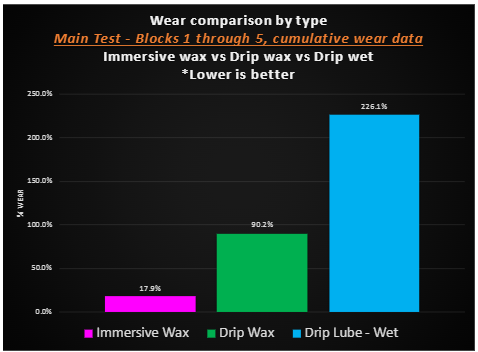By Lennard Zinn
As I explained in a prior blog post, immersive chain waxing can save you a lot of money vs. using oily drip lubes or the original factory lube and anything applied over it. The lower chart here shows how huge those dollar savings can be. If you have a modern aero road or gravel bike with fully internal cables from the stem and bar through the frame, it makes no sense biomechanically or financially NOT to ride on waxed chains. Continuing on the aerodynamic vs. friction savings, it doesn’t even make sense to invest in aero deep-section wheels while eschewing the energy savings that would come with a waxed chain.

Comparison of chain wear by lubricant type – https://zerofrictioncycling.com.au/lubetesting/
Consider not only the many thousands of dollars it costs to own a bike with fully-internal wires and hoses but also the enormous hassle it takes to route those wires and hoses through the handlebar, stem, headset, fork and frame, especially with an integrated carbon stem and bar. Consider further that this hassle must be embarked upon simply to change stem length or handlebar width or to replace the headset—even to raise the bar. And if you must change out that integrated stem/bar for one with a different handlebar width or stem length and/or rise to get the right riding position, that’s a thousand dollars right there. The cost in time and money just to get your position dialed in for comfort and efficiency, both biomechanical and aerodynamic, is huge.
Owning a bike like that, you are paying those costs, plus the price of its carbon deep-section wheels, in order to gain some watts from superior aerodynamics. Those gains will only be seen, however, when riding solo at high speed; they will be irrelevant when drafting among other riders or when riding at low speed, like when climbing (aerodynamic drag increases as the cube of velocity).
Consider the approximately 10-watt power savings of a good deep-section aero wheel vs. a more standard wheel at 35kph (22mph) costing $2,000 or so. Zinn Cycles charges $35 to wax a chain, and it would save 5 watts or so vs. an oiled, dirty chain. That’s $7/watt saved for the waxed chain vs. $200/watt for the aero wheelset! Even if the chain is perfectly cleaned and using one of the best oily lubes (a big time investment to maintain), the savings of only a single watt is still $35/watt for the waxed chain—sixfold that of the aero wheels.
Friction Facts tests of chain lubricants I arranged for Velo/VeloNews magazine in 2013 showed that a chain dipped in paraffin wax (not even a fancy modern chain wax with added friction modifiers) was faster than any drip lube and saved up to 4 watts vs. many drip lubes or the factory lube on a new chain as well as anything applied over it. And that was with clean chains—with dirty chains, the difference is far greater, as an immersion-waxed chain doesn’t get dirty, and an oiled chain picks up grit and gets far slower.
With mountain bikes, cyclocross bikes, and gravel bikes, the difference is even more striking due to the dirt involved. A $35 investment in a waxed chain will continuously save 5 watts and will last years vs. the immediately dirty chains in those disciplines developing a grinding paste of oil mixed with grit inside and will easily wear out the chain in half a season. Now balance that $35 against the cost of the front and rear suspension on the mountain bike to save energy or the cost of a superlight cyclocross (two of them, to be competitive in muddy races), or an efficient gravel bike; investing in chain waxing is a no-brainer.
The power gains of a waxed chain will be realized continuously, not just at high speed when riding solo as with aerodynamic gains. To own an expensive aero road, mountain, cyclocross, or gravel bike and not ride a waxed chain is nonsensical when you consider the relative energy savings alone, not to mention the financial savings.


